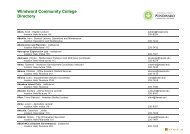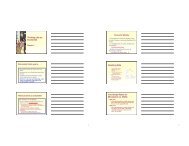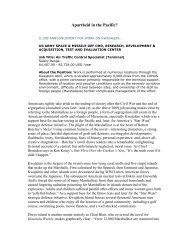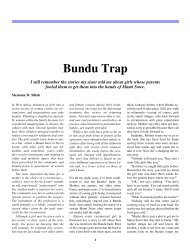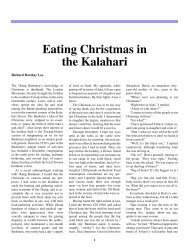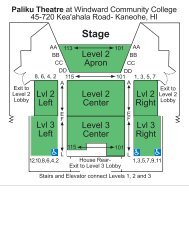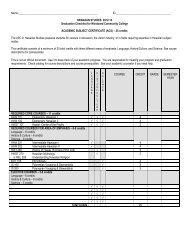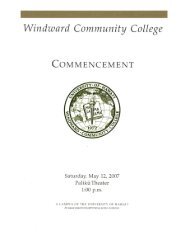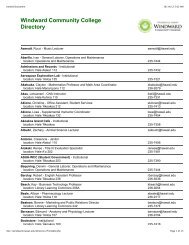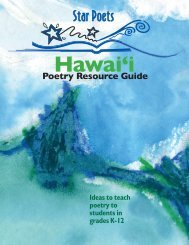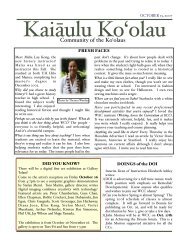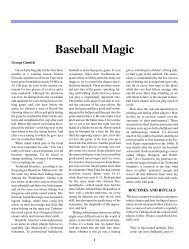GEOG 101 (Online) Syllabus (Summer 2012) - Windward ...
GEOG 101 (Online) Syllabus (Summer 2012) - Windward ...
GEOG 101 (Online) Syllabus (Summer 2012) - Windward ...
Create successful ePaper yourself
Turn your PDF publications into a flip-book with our unique Google optimized e-Paper software.
Geography <strong>101</strong>---- The Natural Environment<br />
WCC <strong>Summer</strong> <strong>Online</strong> Class<br />
03<br />
<strong>Online</strong> Laulima (CRN: 60012)<br />
INSTRUCTOR: Toshi Ikagawa, Ph.D.<br />
OFFICE: Na’auao 116 at WCC<br />
OFFICE HOURS: <strong>Online</strong> via e-mail; or by appointment<br />
TELEPHONE: 236-9216; ikagawa@hawaii.edu<br />
EFFECTIVE DATE: <strong>Summer</strong> <strong>2012</strong><br />
(Updated on: July 1, <strong>2012</strong>)<br />
NOTE: To start <strong>GEOG</strong> <strong>101</strong>, you MUST complete the following 3 tasks (10 extra points)<br />
within the first 2 weeks. They are designed to make you familiar with the procedures<br />
you need to use Laulima:<br />
________________________________________________________________<br />
NOTE: If you have any questions about this course, please e-mail me using my UH email<br />
address (Ikagawa@hawaii.edu), Always include “<strong>GEOG</strong> <strong>101</strong>” in the subject field of<br />
your e-mail, so that I will notice it immediately. This will be automatically done if you use<br />
the Maitool in Laulima. DO NOT use “Private Messages” in Laulima.<br />
________________________________________________________________<br />
1. After carefully reading this syllabus, download the <strong>Syllabus</strong> Acceptance<br />
Form from the Laulima Resources page, fill it up, and submit it via Assignments<br />
tool (into “<strong>Syllabus</strong> Acceptance”) by the end of the 3rd week. You can access the<br />
Resources and Assignments pages by clicking an appropriate name in the Table<br />
of Contents (TOC) on the left column. Without the acceptance, you are NOT<br />
allowed to participate in this course (i.e., dismissed with a failing grade). (No<br />
points assigned)<br />
2. Access the Discussions page from TOC, click Class Discussion, and open<br />
Introduce yourself topic. You can introduce yourself to the class here. Please,<br />
however, refrain from subjects that are not appropriate in public discussion. (5<br />
points)<br />
3. Go a Testing Center and open the Tests and Reviews page from TOC.<br />
Open 00-Pre-survey (30 questions) and answer the questions (The Proctor at<br />
the Testing Center will put in the Password for you; this is the way how you will<br />
take other proctored exams, etc.). This survey is used for a Student Learning<br />
Outcome assessment purpose only. It is NOT an exam (although it is in a test<br />
format, and not anonymous for the purpose of giving points to individuals), thus if<br />
you take it, you will receive the full credit. (5 points)
When you complete the above 3 tasks, you will receive total of extra 10 points. Note<br />
that your points will be posted in the Gradebook under “<strong>Syllabus</strong> Acceptance.” Without<br />
the submission of your syllabus acceptance, the points will not be posted.<br />
WINDWARD COMMUNITY COLLEGE MISSION STATEMENT<br />
<strong>Windward</strong> Community College offers innovative programs in the arts and sciences and<br />
opportunities to gain knowledge and understanding of Hawai‘i and its unique heritage.<br />
With a special commitment to support the access and educational needs of Native<br />
Hawaiians, we provide O‘ahu’s Ko‘olau region and beyond with liberal arts, career and<br />
lifelong learning in a supportive and challenging environment — inspiring students to<br />
excellence.<br />
CATALOG DESCRIPTION<br />
Survey of the natural environment; distribution and interrelationships of climates,<br />
vegetation, soil and land forms.<br />
Activities Required at Scheduled Times Other Than Class Times<br />
This is an online course, thus has no scheduled times.<br />
NOTE: The “proctored” exams/survey/quiz can be only accessible at The Testing<br />
Center (TTC) during the designated period. The proctor at TTC will enter password<br />
for you. You can take each exam ONLY once. Thus you need to go to TTC to take<br />
them.<br />
STUDENT LEARNING OUTCOMES<br />
At the completion of the course, the student should learn to:<br />
UH E-MAIL<br />
1. Describe the components (inputs), processes (actions) and resulting spatial<br />
patterns (outputs) of the physical environment (atmosphere, hydrosphere,<br />
lithosphere and biosphere) as a system.<br />
2. Apply the scientific method, and theories and concepts of geography to<br />
explain a physical environment.<br />
3. Explain critically the interaction of humans and the physical environment.<br />
Occasionally, a rush message is disseminated via the UH e-mail. Please check your UH<br />
e-mail often. Useful information is available at the following:<br />
Forwarding Your UH Mail to Another Email Account<br />
(http://windward.hawaii.edu/facstaff/ikagawa-t/Forwarding%20your%20UH%20Mail.pdf)<br />
REQUIREMENTS COURSE SATISFIES
At WCC: Meets AA degree physical science requirement of the Natural<br />
Science requirements; with <strong>GEOG</strong> <strong>101</strong>L, meets science<br />
laboratory course requirement.<br />
Also full fill marine related elective requirement of the Marine Option<br />
Program (MOP)<br />
At UHM: Meets Natural Science general education requirements (DP); with<br />
<strong>GEOG</strong> <strong>101</strong>L, meets science laboratory course requirement (DY).<br />
RECOMMENDED BASIC SKILLS LEVEL<br />
Ability to read and write at a college level; math at college level.<br />
LEARNING RESOURCES<br />
1. Required Textbook: Geography <strong>101</strong> Book (<strong>Online</strong> Textbook) by Dennis Nullet<br />
This textbook can be accessed at: http://www2.hawaii.edu/%7Edennis/book/<br />
User ID: geog<strong>101</strong><br />
Password: (Available on the Home page and Resources page on Laulima)<br />
2. Lecture Notes: Available on the Laulima Resources page, in 03 Lectures holder<br />
3. Work Book: <strong>GEOG</strong> <strong>101</strong>: The Natural Environment, Semester Work Book is also<br />
available on the Laulima Resources page. This work book is for a face-to-face class<br />
(thus, NOT required for this online class), but you can use it as your resource material.<br />
COURSE TASKS<br />
Dear Geography Students:<br />
Welcome to the Geography <strong>101</strong> course, The Natural Environment. This class examines<br />
the Earth's Natural Environment. The structure and processes of major environments<br />
will be discussed.<br />
Assignments:<br />
It is assumed that you read and understand all the assigned part of the textbook and<br />
lecture notes as assigned. There will be a weekly quiz on the materials covered in the<br />
textbook as well as in the lecture notes, which will be counted toward your final grade.<br />
Participation:<br />
Participation is mandatory.<br />
Also, any changes in the content/material/schedule/procedure related to the class,<br />
announced on Laulima will stand, even if you are not aware. It is your responsibility to<br />
obtain such information from Laulima site, or any other sources.
ASSESSMENT TASKS AND GRADING<br />
Student Evaluation (Also refer to the Grading Flowchart below):<br />
1. You must complete the Pre Survey during the first two weeks of the semester (extra<br />
points, and mandatory). Go to a Testing Center and open the Tasks, Tests and Surveys<br />
page from Laulima. Open <strong>101</strong>-Pre-Survey (30 questions) and answer the questions<br />
(The Proctor at the Testing Center will put in the Password for you).<br />
Requirement 1: You must complete (1) Pre-survey. If you do not complete this<br />
initial task, you will not be allowed to participate in this class thereafter.<br />
2. There will be three Exams (40 points each),12 Weekly Quizzes (5 points each, 60<br />
points) and Participation (30 points) for the evaluation (Total 210 points). Reviews for<br />
Exams are available as Reviews for Multiple Choice Exams in the Resources on Laulima<br />
(Printable version in 02-Reviews holder). This requirement is used to determine your final<br />
letter grade, if you meet all requirements.<br />
Requirement 2: You must achieve 60% or better of the total of exams and<br />
attendance/participation to pass the course.<br />
3. There will be a mandatory Capstone Quiz near the end of the semester (extra points<br />
according to your achievement). It covers everything covered in the class. Review for the<br />
Capstone Quiz is available in the Resources page on Laulima (<strong>GEOG</strong> <strong>101</strong> Key Concepts<br />
and Terms in 01-Key Concepts holder). Understand (not just memorize their definitions)<br />
the concepts and terms listed. Take this requirement seriously.<br />
Requirement 3: You must achieve 70% or better for the quiz to pass the course.<br />
4. If you fail to meet one or both of the above two requirements (only if the results of the<br />
Capstone Quiz is 50.0-69.9%), there will be a Makeup Exam (makeup for the entire<br />
course, NOT for a missed exam). Makeup Exam covers materials for the three previous<br />
exams (This is NOT a mere makeup for the Capstone quiz).<br />
Requirement 4: To pass the course, you must achieve 80% or better.<br />
5. Participation (via Discussion) will be used to evaluate each student’s achievement of<br />
course objectives listed above. Students missing discussion regularly (i.e. more than<br />
10% of possible number of entries), cannot be assessed for these objectives and<br />
therefore will not be able to pass the course. Normally 60 entries required.<br />
Requirement 5: No more than 10% missing discussion entries<br />
NOTE: Requirement 5 is eased for the <strong>Summer</strong> Class. But please<br />
participate in the online discussion as much as possible. Your participation<br />
will be considered as extra credit points.<br />
Please mark your calendar now.<br />
Tasks Material Covered Date
Pre-Survey<br />
Weekly Quiz<br />
(Ch 1—12)<br />
Exam 1<br />
Exam 2<br />
Exam 3<br />
Capstone<br />
Quiz*<br />
Makeup<br />
Exam<br />
Multiple choice questions about the<br />
natural environment<br />
Multiple choice questions for<br />
Textbook and Lecture notes (PDF)<br />
(2 quizzes or more per week; each<br />
covers 1 chapter and 2 lecture<br />
notes)<br />
Multiple choice questions for<br />
Textbook: Chapters 1–4<br />
Multiple choice questions for<br />
Textbook: Chapters 5–8<br />
Multiple choice questions for<br />
Textbook: Chapters 9–12<br />
Multiple choice questions from<br />
Lectures (Key Concepts & Terms)<br />
*Based on the understanding of the<br />
lectures<br />
Multiple choice questions for<br />
Textbook: Chapters 1--12<br />
1 st — 2 nd weeks<br />
on Laulima<br />
1 st – 6 th weeks<br />
on Laulima<br />
NOT proctored, so you can<br />
take it at home<br />
3 rd -- 4 th week<br />
on Laulima<br />
4 th – 5 th week<br />
on Laulima<br />
5 th -- 6 th week<br />
on Laulima<br />
5 th -- 6 th week<br />
on Laulima<br />
6 th weeks<br />
on Laulima<br />
Discussion Discussion on the topic of the week Reasonable entries*<br />
Considered as extra credit<br />
*: “Reasonable” means that a single-line comments such as “That’s great!” will not count.<br />
Use your common sense, please.<br />
NOTE 1: Exact open and due dates of each exam/quiz are available on Tasks, Tests &<br />
Surveys page on Laulima. Exams, etc. are due at 3 p.m. of the due date, not at the time<br />
of a testing center closes.<br />
NOTE 2: Exams and quizzes cover both lectures and the textbook. It is mandatory to read<br />
all the reading materials. Each exam/quiz includes multiple-choice questions, including<br />
true/false questions. When you study, it is strongly recommended to check ideas and<br />
concepts using the textbook. (1) Key concepts and terms and (2) review questions for<br />
multiple choice questions are available in the Resources page on Laulima.<br />
NOTE 3: No personal items, including electronic device (such as a cell phone and iPad),<br />
are allowed during the proctored assignments.<br />
NOTE 4: No reference materials, including other Laulima pages of the class, are allowed<br />
when you take proctored exams, etc.<br />
How to access Laulima<br />
1. Go to the Laulima entry page at:<br />
https://laulima.hawaii.edu/portal<br />
2. Log in using your UH Banner ID and password.<br />
3. Select the class from the “My Workspace” bar near the top and click.
4. On the left side, there is the table of contents (Home, <strong>Syllabus</strong>, Exams, Resources, etc.).<br />
Click to access.<br />
NOTE: The exams/survey/quiz can be only accessible at The Testing Center<br />
(TTC) during the designated period. The proctor at TTC will enter password for<br />
you. You can take each exam ONLY once.<br />
Academic dishonesty: (SERIOUS WARNING!!)<br />
Academic dishonesty such as cheating and plagiarism that may occur in this class will be<br />
severely punished. It most likely will result in immediate dismissal from the class. In other<br />
words, “DON’T DO IT” even if you have noble reasons to do so. It is NOT worth a try it in<br />
this class.<br />
Grading uses the standard scale:<br />
1. A: 90.0-100.0%, B: 80.0-89.9%; C: 70.0-79.9%, D: 60.0-69.9%, F: 0-59.9%.<br />
2. For Cr/NC options, Incomplete (“I” grade), and “W” grade, see the WCC<br />
College Catalog.<br />
3. There is no “N” grade in this class.<br />
NOTE:<br />
1. There is NO extra credit work except those noted above.<br />
2. There are NO make-ups for missed exams.<br />
<strong>GEOG</strong> <strong>101</strong> Grading Flowchart<br />
Grading involves the following:<br />
1. Pre-Survey<br />
2 Exams 1, 2 & 3 (plus Attendance/Participation points)<br />
3. Capstone Quiz<br />
4. Attendance/Participation<br />
5. Makeup Exam<br />
START:<br />
Pre-survey<br />
Took?<br />
No<br />
Yes<br />
Capstone Quiz<br />
≥ 70.0% ?<br />
Yes<br />
Exams 1, 2 & 3<br />
(plus Quiz/Par.<br />
pts.)<br />
≥ 60.0% ?<br />
No<br />
No<br />
Capstone Quiz<br />
50.0-69.9% ?<br />
Yes<br />
Make up Exam<br />
(for minimal pass)<br />
≥ 80.0% ?<br />
No<br />
No
Secrets of Success: Two key factors are especially important<br />
(1) Self-motivation: Because this is an online course, nobody will push you to do<br />
the work. Thus, self-motivation is a key factor of success in this course.<br />
(2) Communication: You are not alone. Continuous and open discussion among<br />
all participants is strongly recommended. You can use the “Class Discussion”<br />
pages available in the Discussions tool of Laulima to communicate with each other.<br />
Group work and corroboration is encouraged (i.e., help each other).<br />
Exams (online):<br />
(1) You will take your 3 Exams and Capstone Quiz (and if necessary Makeup<br />
Exam) via Laulima at a Testing Center (TTC), such as one on <strong>Windward</strong><br />
Community College campus, by the Due Dates.<br />
! You can take each exam ONLY once.<br />
NOTE: If necessary, you can arrange to take exams at other designated testing<br />
sites. Please contact the instructor to set up your testing site.<br />
The list of locations is found at:<br />
Discussion (online):<br />
Yes<br />
Attendance/Participation<br />
Absences ≤ 10% ?<br />
Congratulations!<br />
Passing Grade<br />
http://www.hawaii.edu/dl/faculty/prep/proctor_office.html<br />
(1) Like you did in “Introduce Yourself” exercise, post your Report (i.e. your<br />
reactions, opinions, etc.) in the appropriate topic area in the Class Discussions<br />
section of Discussions by the due date. For example, you can report What you<br />
think, why this way, what can we do, etc.<br />
No<br />
Super Massive<br />
Black Hole<br />
Fail the Class
________________________________________________________________<br />
WARNING: Please do NOT share the Discussions tool with a third party. Any<br />
violation of this confidentiality will lead you to dismissal from this course, at least.<br />
________________________________________________________________<br />
You can seek help from your fellow students by posting your problems in the Class<br />
Discussions section. It is strongly encouraged that you help each other.<br />
To access Class Discussions:<br />
Log in to Laulima Go to <strong>GEOG</strong> <strong>101</strong> page<br />
TOC > Discussions and Private Messages Tools<br />
The Discussions opens. Go to Class Discussion. Click on the appropriate topic and<br />
compose your message. Your report should NOT exceed 250 words.<br />
You can add your picture, or any picture you like (of course, nothing obscene or<br />
offensive, please), in Discussion and Private Messages, My Profile. Go to "Avatar"<br />
at the bottom of the page. Please use rather small pictures.<br />
To compose your report, an easy way is to type your report using MS Word or other<br />
word processor, and then copy and paste it in a message. Don’t forget your Name.<br />
Also, be sure to Reply to at least one entry in the Discussions. In other words, you<br />
write your reaction to at least one person’s report. You will write FOUR entries in<br />
the Discussion for each week’s topic. Again, you are strongly encouraged to assist<br />
your fellow students.<br />
! Discussion for each topic remains open until the end of the week (Saturday). Be<br />
sure to report and reply within this time period.<br />
________________________________________________________________<br />
NOTE: If you have any questions about this course, please e-mail me using my UH e-mail<br />
address (Ikagawa@hawaii.edu), Always include “<strong>GEOG</strong> <strong>101</strong>” in the subject field of your email,<br />
so that I will notice it immediately. This will be automatically done if you use the<br />
Maitool in Laulima. DO NOT use “Private Messages” in Laulima.<br />
________________________________________________________________<br />
COURSE CONTENT<br />
The Natural Environment (<strong>GEOG</strong> <strong>101</strong>) Schedule<br />
Subjects (Reading assignment of Textbook & Lecture notes)<br />
NOTE: Textbook readings are ahead of Lecture notes<br />
WEEK 1(Textbook Ch 1 & 2 and Lecture notes #01, 02, 03 & 04)<br />
INTRODUCTION<br />
1. Introduction (Preface), Scientific method, systems approach<br />
2. Organizing concepts, Geographic grid system (Chapter 1: Maps)<br />
3. Maps and map projections, map scales
4. GIS/GPS<br />
PART 1: ATMOSPHERE<br />
5. Overview of atmosphere (Chapter 2: Sky): Solar system, solar radiation<br />
6. Seasons, analemma, composition of atmosphere, profiles of atmosphere<br />
WEEK 2 (Textbook Ch 3, 4 & 5 and Lecture notes #05, 06, 07, 08, 09 & 10)<br />
7. Energy and temperature (Chapter 3: Heat): Heat transfer, transmission, radiation<br />
balance, land-ocean contrast<br />
8. Pressure and winds (Chapter 4: Wind): Pressure gradient, high/low pressures &<br />
winds, land/sea breezes, Coriolis<br />
9. Global circulation, real winds, ocean currents, monsoon<br />
WEEK 3 (Textbook Ch 6, 7 & 8 and Lecture notes #11, 12, 13, 14, 15 & 16)<br />
PART 2: HYDROSPHERE<br />
10. Moisture and precipitation (Chapter 5: Clouds): Atmospheric moisture, phase<br />
change, humidity<br />
11. Ground level condensation<br />
12. Clouds and storms (Chapter 6: Weather): Clouds<br />
13. Orographic rainfall, adiabatic process, convectional rifting, precipitation types<br />
14. Air masses & mid-latitude cyclones, thunderstorms, tornadoes, hurricanes vs<br />
mid-lat cyclone<br />
15. Climate (Chapter 7: Water): Climate classification, Hadley cell & tropical<br />
rainforest, Subtropical Highs & dry climate<br />
16. Climate PPS, water resources<br />
WEEK 4 (Textbook Ch 9 & 10 and Lecture notes #17, 18, 19 & 20)<br />
PART 3: BIOSPHERE<br />
17. Biogeography and ecosystems (Chapter 8: Life): Ecosystems & food chain<br />
18. Vegetation zones, terrestrial biomes<br />
19. Soils and vegetation: soils, laterization<br />
PART 4: LITHOSPHERE<br />
20. Plate tectonics (Chapter 9: Earth): Geologic time, Interior of the Earth<br />
21. Plate tectonics<br />
22. Minerals and rocks (Chapter 10: Mountains): Rock cycle<br />
23. Tectonic processes, faulting & folding<br />
WEEK 5 (Textbook Ch 11 & 12 and Lecture notes #21, 22, 23 & 24)<br />
24. Building/decreasing processes (Chapter 11: Valleys), volcanism, shield volcano,<br />
weathering, karst landscape<br />
25. Fluvial landscapes (Chapter 12: Erosion)<br />
26. Wind, sand dunes<br />
WEEK 6 (contents of Lecture notes #23 & 24)<br />
27. Earth ecosystem<br />
28. Summary<br />
NOTE: Schedule/subjects may change without prior notice.
Disabilities Accommodation Statement<br />
If you have a physical, sensory, health, cognitive, or mental health disability that could<br />
limit your ability to fully participate in this class, you are encouraged to contact the<br />
Disability Specialist Counselor to discuss reasonable accommodations that will help you<br />
succeed in this class. Ann Lemke can be reached at 235-7448, lemke@hawaii.edu, or<br />
you may stop by Hale ‘Akoakoa 213 for more information.<br />
Additional Information<br />
Legal assumptions:<br />
It is hereby assumed that you will strictly follow all and any reasonable<br />
procedures/ethics, etc. that are enforced in this academic institution. Refer to the<br />
Student Conduct Code (http://www.hawaii.edu/apis/ep/e7/e7208.pdf) for the details.<br />
Last revised: July 1, <strong>2012</strong>



